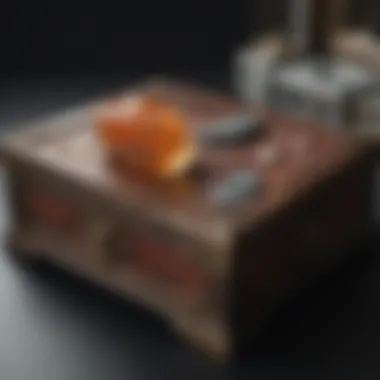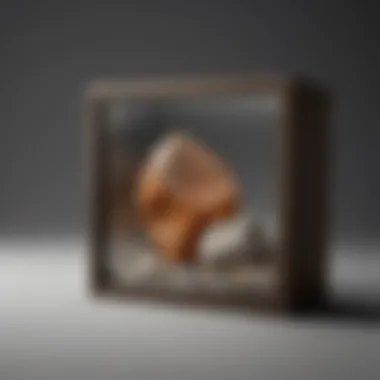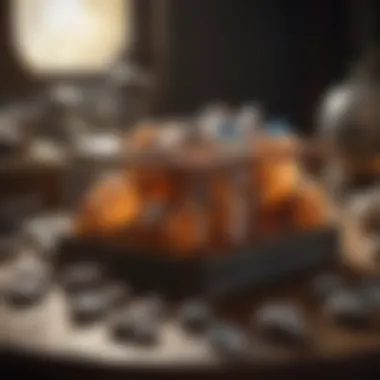Mastering the Art of Showcasing Mineral Specimens: A Complete Guide to Mineral Display Boxes


Rock and Fossil Identification
Rock and fossil identification is a fundamental aspect of the world of mineral specimen display boxes. To effectively showcase prized specimens, collectors must familiarize themselves with various types of rocks and fossils. This includes being able to discern key characteristics such as color, texture, and composition. Utilizing tools such as magnifying glasses, streak plates, and hardness picks can aid in the identification process, allowing collectors to accurately classify and appreciate their specimens.
Collecting Tips and Techniques
When it comes to collecting rocks and fossils for display, adhering to best practices is essential. Collectors should research and identify prime collecting sites known for their richness in specimens. Proper techniques for extracting specimens without causing damage should be employed to ensure the integrity of the rocks and fossils. Safety measures must also be taken into consideration to minimize risks during the collection process, promoting a sustainable and responsible approach to acquiring specimens.
Preservation and Display
Preserving rocks and fossils is crucial to maintaining their aesthetic appeal and scientific value. Adopting techniques such as sealing specimens in protective coatings, storing them in acid-free containers, and controlling environmental factors like light and humidity sustain their longevity. Creative display ideas, such as arranging specimens by color or geological era, can enhance the visual impact of mineral collections and provide a unique viewing experience for enthusiasts and visitors alike.
Geological Insights
Delving deeper into geological insights offers enthusiasts a broader understanding of the rocks and fossils they collect and display. Exploring the formations and processes that have shaped the Earth's crust over millions of years illuminates the context in which these specimens are found. Understanding the historical significance of certain rocks and fossils, as well as notable discoveries in the field of geology, adds a layer of appreciation and wonder to the art of displaying mineral specimens in curated display boxes.
Introduction
In the realm of mineral specimen curation, the presentation plays a pivotal role in magnifying the intrinsic beauty and scientific significance of each rock or fossil. This article embarks on a journey into the exquisite world of mineral specimen display boxes, unraveling the art of showcasing these geological treasures with finesse and sophistication. By delving into the nuances of display aesthetics and functionality, this guide aims to arm collectors, both novices and connoisseurs, with the knowledge and tools necessary to elevate their mineral collections to museum-worthy exhibitions.
Understanding Mineral Specimen Display
Defining mineral specimen display boxes
At the core of any well-curated mineral collection lies the choice of display box. These containers serve as the stage on which each specimen shines, providing a protective yet visually appealing enclosure. Mineral specimen display boxes are specially crafted showcases designed to enhance the viewing experience of collectors and admirers alike. Their transparent panels, often made of glass or acrylic, allow for unobstructed views of the specimens within, offering a glimpse into the geological wonders held within. The allure of these display boxes lies in their ability to safeguard fragile specimens while adding a touch of elegance to the overall presentation. However, their delicate nature requires careful handling to prevent damage and ensure longevity.
The significance of showcasing mineral specimens
Beyond mere protection, displaying mineral specimens serves a crucial purpose in the realm of geology and natural history. Showcasing these treasures not only highlights their aesthetic appeal but also educates viewers on the diversity and complexity of the Earth's geological formations. It provides a platform for enthusiasts to share their passion for rocks and fossils, sparking curiosity and appreciation among the audience. The act of showcasing mineral specimens bridges the gap between science and art, transforming mundane rocks into captivating works of nature's artistry. Through strategic presentation and thoughtful curation, collectors can convey the rich history and geological significance encapsulated within each specimen, enriching the viewing experience for all.
Purpose of the Guide


Empowering collectors with display options
An integral aspect of this guide is to empower collectors with a myriad of display options that cater to their unique preferences and collections. By understanding the diverse range of display boxes available, collectors can curate their exhibits to reflect their individual style and taste. Whether opting for sleek glass cases, rustic wooden boxes, or modern acrylic stands, collectors have the freedom to customize their displays to suit the ambiance of their spaces. This empowerment not only enhances the visual appeal of the specimens but also transforms the act of collecting into a personalized and enriching experience.
Enhancing the aesthetic presentation of specimens
The aesthetic presentation of mineral specimens goes beyond mere visual allure; it encapsulates a harmonious blend of scientific intrigue and artistic flair. By exploring innovative display options and incorporating creative elements such as lighting and background effects, collectors can transform their exhibits into captivating showcases that mesmerize and educate viewers. Enhancing the aesthetic appeal of specimens not only elevates their intrinsic beauty but also fosters a deeper appreciation for the natural world. Through thoughtful presentation and meticulous attention to detail, collectors can curate displays that not only dazzle the eye but also inspire a sense of wonder and curiosity in observers.
Choosing the Right Display Box
When it comes to displaying mineral specimens, selecting the appropriate display box is a critical aspect that can significantly impact the overall presentation. The choice of display box plays a vital role in not only safeguarding the specimens but also enhancing their visual appeal. By carefully considering various elements such as size, material quality, and visibility, collectors can ensure that their prized specimens are showcased in the best possible manner.
Types of Mineral Specimen Display Boxes
Glass Display Cases
Glass display cases are a popular choice among collectors due to their elegant and transparent nature, which allows for clear viewing of the specimens. The key characteristic of glass display cases lies in their ability to provide a sleek and modern display option that complements the beauty of the minerals. One unique feature of glass display cases is their ability to protect specimens from dust and other external elements while providing a stylish showcase. However, a disadvantage of glass display cases is their fragility and susceptibility to breakage if mishandled.
Wooden Display Boxes
Wooden display boxes offer a classic and rustic appeal that appeals to collectors looking for a traditional display option. The key characteristic of wooden display boxes is their sturdy construction, which provides durability and protection for the specimens. One unique feature of wooden display boxes is their customizable nature, allowing collectors to add personal touches through engravings or unique finishes. Despite their aesthetic appeal, wooden display boxes may require more care to prevent moisture damage compared to other display options.
Acrylic Display Stands
Acrylic display stands are favored for their lightweight and versatile nature, making them an ideal choice for collectors seeking a modern and sleek display solution. The key characteristic of acrylic display stands is their transparency and impact-resistant properties, which ensure that specimens are showcased prominently and securely. One unique feature of acrylic display stands is their ease of customization, allowing for various display arrangement options. However, a potential disadvantage of acrylic display stands is their susceptibility to scratching, which may require regular maintenance to preserve their visual appeal.
Considerations for Selection
Size and Dimensions
The size and dimensions of a display box play a crucial role in determining how effectively specimens are showcased. Collectors should consider the size of their specimens and the available display space to ensure a proper fit. The key characteristic of size and dimensions is their influence on the overall layout and organization of the display, enhancing the visual impact for viewers. One unique feature is the ability to choose display boxes in different sizes to accommodate various specimens. However, a potential disadvantage is selecting a box that is too small, which may limit the visibility of specimens.


Material Quality
The material quality of a display box is essential for ensuring the longevity and protection of mineral specimens. Collectors should prioritize sturdy and durable materials that can withstand environmental factors and preserve the specimens' integrity. The key characteristic of material quality is its impact on the overall aesthetics and safety of the display. One unique feature is the availability of display boxes in different materials such as glass, wood, or acrylic, providing collectors with a range of options to suit their preferences. However, poor material quality may lead to damage or deterioration of specimens over time.
Visibility and Accessibility
Display boxes should offer optimal visibility and accessibility to allow viewers to appreciate the specimens from various angles. The key characteristic of visibility and accessibility lies in their ability to showcase specimens clearly without obstruction. Collectors should consider factors such as transparent materials and easy access to specimens when selecting a display box. One unique feature is the consideration of adjustable shelves or lighting options to enhance visibility. However, a potential disadvantage is choosing a display box that restricts access to specimens or limits visibility due to structural constraints.
Customization and Personalization
Engraving Options
Engraving options provide collectors with a unique way to personalize their display boxes and add a personal touch to the showcase. The key characteristic of engraving options is the ability to customize display boxes with names, dates, or other inscriptions, enhancing the sentimental value of the display. One unique feature is the versatility of engraving techniques, allowing for intricate designs or simple text additions. However, excessive engraving may overwhelm the overall aesthetics of the display.
Display Arrangement Flexibility
Display arrangement flexibility allows collectors to creatively showcase their specimens and adapt the display to suit their preferences. The key characteristic of display arrangement flexibility is the freedom to experiment with different layouts and configurations to highlight the specimens' unique features. One unique feature is the ability to rearrange specimens easily without damaging the display box. However, a potential disadvantage is overcrowding the display box, which may diminish the individual impact of each specimen.
Display Box Maintenance and Care
In the realm of mineral specimen display boxes, proper maintenance and care play a pivotal role in preserving the integrity and beauty of your prized collections. This section delves into the essential aspects of maintaining and caring for your display boxes to ensure longevity and optimal showcasing conditions. By focusing on display box maintenance and care, collectors can safeguard their specimens from damage and deterioration, enhancing the overall presentation and appeal of their valuable rocks and fossils.
Cleaning and Preservation
Dust removal techniques
Dust removal techniques are a fundamental aspect of display box maintenance, serving to eradicate dust particles that can obscure the visibility and aesthetic allure of mineral specimens. The meticulous application of dust removal techniques ensures that your display boxes remain pristine, allowing light to reflect off the specimens unimpeded. Utilizing gentle brushes, microfiber cloths, or compressed air, collectors can effectively remove dust without causing harm to delicate specimens. The versatility and effectiveness of dust removal techniques make them a popular choice for collectors seeking to maintain the immaculate appearance of their displayed minerals.
Preventing moisture damage
Preventing moisture damage is paramount in ensuring the longevity and preservation of mineral specimens within display boxes. Moisture can lead to degradation, discoloration, or even mold growth on specimens if left unchecked. Implementing moisture-absorbing materials, such as silica gel packets, or utilizing hygrometers to monitor humidity levels within display cases can mitigate the risks of moisture damage. By taking proactive measures to prevent moisture accumulation, collectors can safeguard their collections from harmful environmental effects, preserving the intrinsic beauty and structural composition of their specimens.


Enhancing Display Appeal
Enhancing display appeal plays a pivotal role in elevating the presentation of mineral specimens, captivating the viewer's attention through thoughtful design choices and aesthetic considerations. In this article focused on the art of displaying mineral specimens, the section on enhancing display appeal explores the crucial elements that contribute to creating a visually striking showcase for rock and fossil collections. By optimizing the presentation of mineral specimens, collectors can highlight the unique features and beauty of each piece, fostering a deeper appreciation for the world beneath the surface.
Lighting and Background
Strategic Placement for Optimal Lighting
Strategic placement for optimal lighting is a key aspect of enhancing display appeal in the context of mineral specimen display boxes. The strategic positioning of lighting sources can dramatically impact the visibility and overall appeal of the specimens. By strategically placing lights to minimize shadows and highlight the intricate details of the minerals, collectors can create a visually engaging display that showcases the specimens in their best light. This technique not only enhances the aesthetic appeal of the display but also allows viewers to appreciate the mineral specimens in their full glory.
Background Selection for Contrast
Selecting the right background for mineral specimens is crucial in creating a visually compelling display that enhances the overall appeal of the collection. Contrast is a vital element in drawing attention to the individual specimens, ensuring they stand out effectively against the backdrop. By choosing backgrounds that complement the colors and textures of the minerals, collectors can create a visually harmonious display that showcases the beauty and diversity of their collection. The contrast provided by the background serves to accentuate the unique characteristics of each specimen, allowing for a more engaging and aesthetically pleasing display.
Labeling and Information Display
Informative Labels for Specimens
In the context of mineral specimen display boxes, informative labels play a crucial role in providing viewers with essential information about the specimens on display. These labels offer detailed insights into the specimen's name, geological characteristics, origin, and any other relevant details that enhance the viewer's understanding and appreciation of the collection. Informative labels not only serve an educational purpose but also add a layer of sophistication to the display, elevating it beyond mere visual appeal.
Displaying Geological Information
Displaying geological information alongside mineral specimens enriches the viewing experience by offering a deeper insight into the geological significance of the collection. By providing details such as geological formations, mineral composition, and historical context, collectors can create a more immersive and educational display that appeals to enthusiasts and novices alike. This integration of geological information not only adds depth to the display but also fosters a greater appreciation for the earth's rich mineral diversity.
Conclusion
Concluding the extensive exploration of mineral specimen display boxes, it is evident that the art of showcasing these prized collections in an elegant and thoughtful manner is a key aspect for enthusiasts. The culmination of each meticulous selection and curation process reflects not only the value of the specimens but also the dedication and passion of the collector. The importance of the conclusion lies in solidifying the knowledge acquired throughout the guide, emphasizing that effective display methods not only enhance the visual appeal of mineral specimens but also offer a platform for education and admiration among fellow collectors. By investing time in understanding the significance of selecting the right display box, collectors can elevate their displays from merely showcasing rocks and fossils to creating captivating narratives that inspire and educate observers.
Final Thoughts
Reflecting on the Art of Display
Reflecting on the art of display within the realm of mineral specimen showcasing holds a pivotal role in the overall presentation and experience. This introspective act enables collectors to appreciate the intricate details of their collections, fostering a deeper connection between the specimens and the curator. The focal point of reflecting on the display process lies in its ability to act as a creative outlet, allowing for personal expression and artistic interpretation. Consequently, collectors can transform their display boxes into miniature exhibitions that tell stories of geological wonders and historical significance, captivating viewers and igniting curiosity about the natural world. The unique feature of reflecting on the art of display is its capacity to transcend mere presentation, turning each display into a dynamic and engaging visual narrative that mesmerizes audiences. This reflective practice adds depth and meaning to the collector's experience, enriching the display process with a sense of purpose and fulfillment.
Inspiring Others in the Collector Community
Inspiring others in the collector community through the art of display serves a dual purpose of fostering a sense of camaraderie and encouraging growth within the niche. By sharing one's creative display techniques and unique approaches, individuals within the collector circle can ignite inspiration and spark creativity among their peers. The significant contribution of inspiring others lies in its ability to create a ripple effect of innovation, where each collector's distinct style and flair contribute to a diverse tapestry of display aesthetics. Embracing the role of an inspirer not only elevates one's standing within the community but also cultivates a culture of exchange and mutual appreciation for the art of showcasing mineral specimens. The advantageous aspect of inspiring others is its potential to create a supportive and engaging environment where enthusiasts can learn from each other, exchange ideas, and collectively elevate the standard of mineral specimen display. This communal inspiration fosters a sense of unity and shared passion, propelling the collector community towards greater creativity and excellence in the realm of mineral specimen display.







